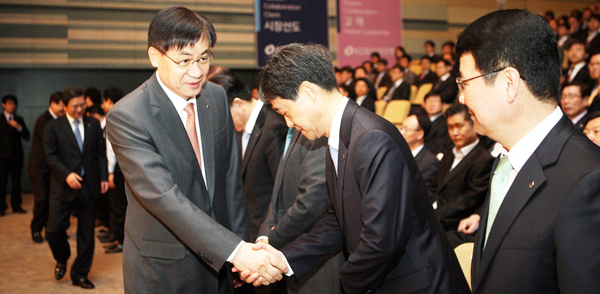KDB celebrates past, looks to future

Hong Ky-tack, chairman of KDB Financial Group, left, shakes hands with executives at a ceremony to mark the state-run financial institution’s 60th anniversary at the group’s headquarters in Yeouido, western Seoul, yesterday. Provided by the group
Under the new slogan of “Financial Engine for Korea and the World,” the state-run bank pledged to play a leading role in advancing the public financial sector and establishing the creative economy envisioned by the Park Geun-hye government.
The former Lee Myung-bak administration attempted to privatize KDB to make it an investment-specialized bank like JPMorgan, Morgan Stanley or Merrill Lynch, but the Park government withdrew the plan in August and decided to merge the bank with KoFC to enhance the function of public finance.
In January, the Ministry of Strategy and Finance announced that KDB, its holding company and the Industrial Bank of Korea had been recategorized as public institutions two years after they were removed from the list.
The former administration’s deadline for the privatization of KDB Financial Group was May 2014.
The Lee government separated KoFC from KDB in 2009 to reduce the bank’s policy-financing business involving financial projects that the government makes to support certain areas of business or industry. The Park administration said the work of the KDB overlapped with the KoFC.
The vision involves generating net profits of more than 1 trillion won ($945 billion) and increasing overseas sales as much as 20 percent by 2018.
This year, it pledged to make 630 billion won in net profit and reduce costs to 751 billion won. Last year, due to worse-than-expected performances by local businesses, KDB logged 1.44 trillion won in net losses and ended up with more than 2.2 trillion won in expenses.
The bankruptcy of STX Group was a major burden on the bank, which caused it to post its first deficit in 13 years. It now aims to accumulate 114.4 trillion won in operating assets and also decided to provide 25.5 trillion won for small businesses.
The merger with KoFC is expected to be completed within a year.
“As a financial engine of Korea, KDB should play a leading role in sectors where private financial institutions are unable to perform,” said Hong Ky-tack, chairman of KDB Financial Group at a ceremony yesterday. “The paradigm that public finance corporations are forgiven for losses is a thing of the past. KDB will pursue strong surpluses.”
He also emphasized the importance of increasing joint research with foreign institutions and pioneering new businesses overseas. “Learning from KBD’s predecessors who worked hard to make the bank a leader in business banking and investment finance, we will continue the efforts to make it one of leaders in realizing unification of the country,” Hong said.
KDB was established with about 40 million won in capital in 1954, when Korea’s GDP barely reached $1.5 billion and was a major contributor to rebuilding the war-torn country into a manufacturing powerhouse. It financed the country’s chemical and heavy industries in the 1970s and the automobile and semiconductor industries in the 1980s.
BY SONG SU-HYUN [ssh@joongang.co.kr]










with the Korea JoongAng Daily
To write comments, please log in to one of the accounts.
Standards Board Policy (0/250자)